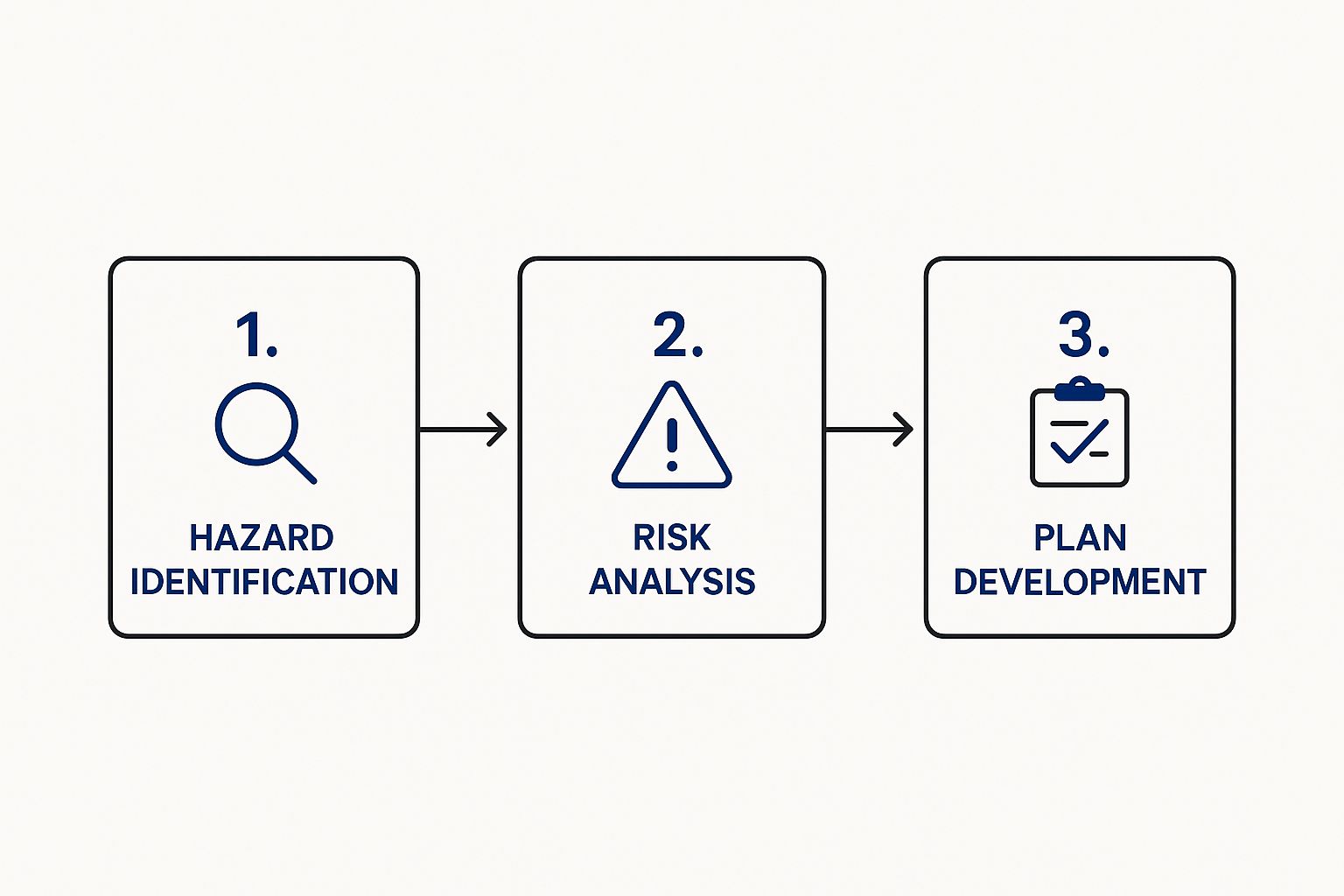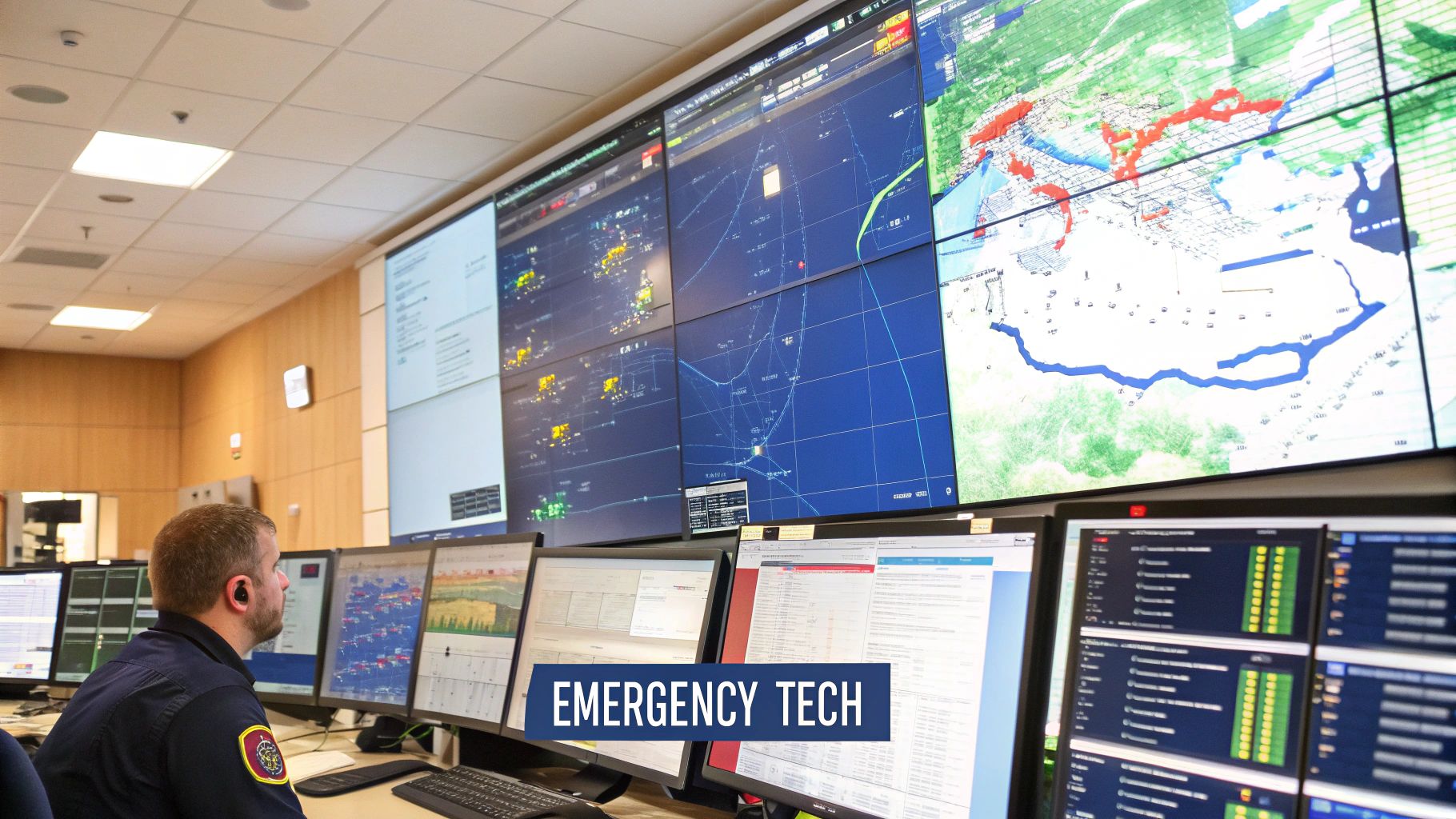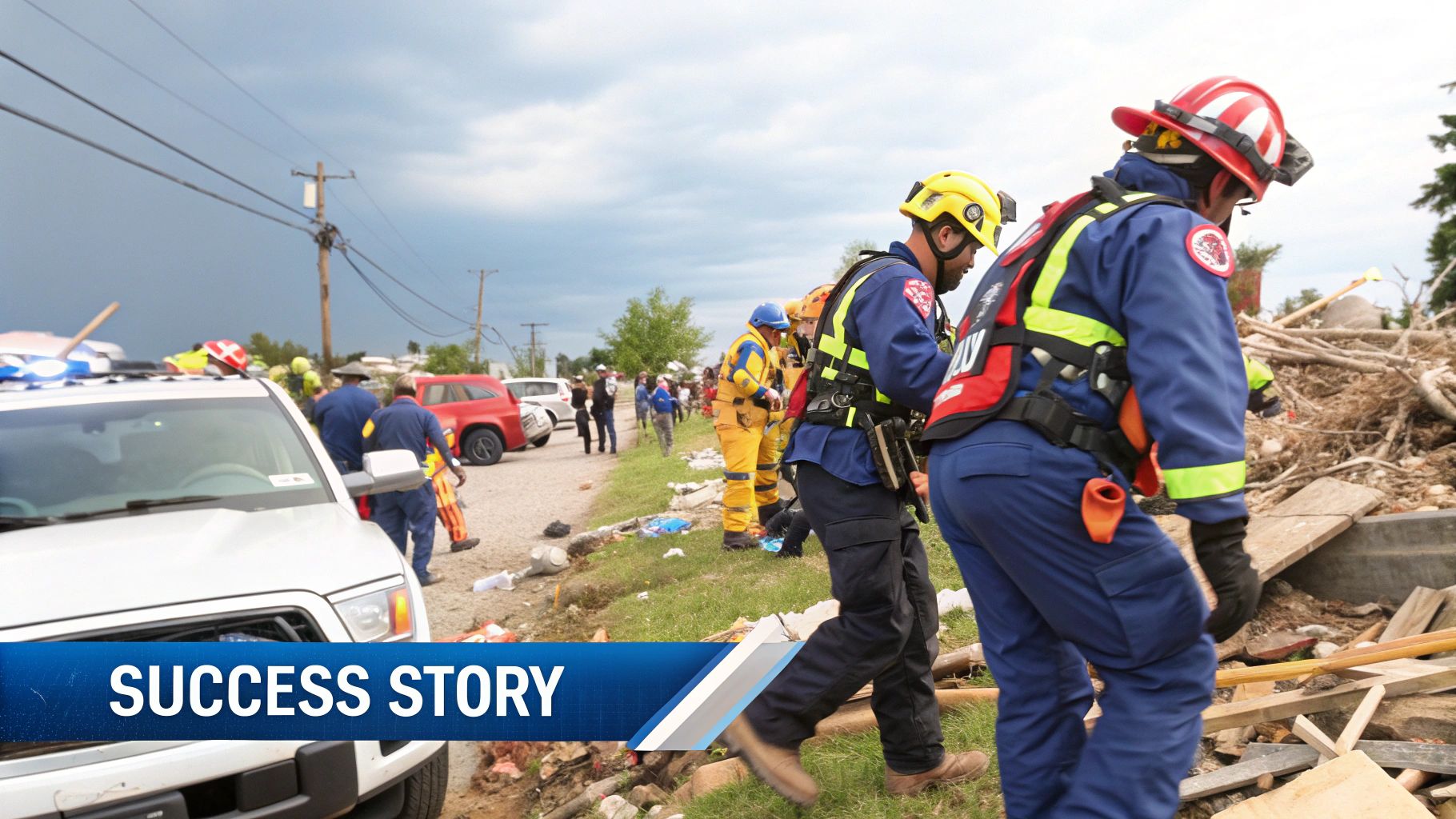For business leaders in Texas, particularly in sectors like Energy, Petrochemical, Manufacturing, and Logistics, the conversation has shifted from vague disaster plans to the critical need for specialized emergency management companies. This is no longer an abstract concept but a core operational necessity.
With increasing climate volatility impacting supply chains, infrastructure, and employee safety, the financial and reputational risks are clear and present. A proactive partnership with an emergency management firm is not just a best practice; it is a fundamental component of operational resilience.
Why Partnering with an Emergency Management Firm Is Critical for Texas Industries
For any company operating in Texas, the question isn't if a major weather event will occur, but when and with what severity. Gulf Coast hurricanes can shut down petrochemical facilities for weeks, and extreme heat often brings construction projects to a halt, demonstrating the massive operational and financial stakes.
While an internal safety committee is essential, it often lacks the specialized expertise, on-call resources, and 24/7 readiness required to manage a large-scale crisis. The scope and complexity are vastly different.
Engaging a dedicated emergency management company provides a structured framework for resilience that goes far beyond a static plan in a binder. These firms bring critical capabilities that businesses in high-risk sectors cannot afford to overlook.
Key Benefits of a Strategic Partnership
Working with emergency management experts provides immediate access to a deep well of knowledge and resources. A professional firm delivers:
- Comprehensive, industry-specific response plans that account for the complex realities of regulatory compliance (e.g., TCEQ, EPA) and unique operational dependencies.
- Access to a network of pre-vetted resources, including heavy equipment, temporary labor, and logistics support—invaluable when local resources are overwhelmed during a regional event.
- Realistic training and drills designed to ensure your team knows precisely what to do when stress levels are at their peak.
- Real-time monitoring and predictive analytics to provide early warnings. This capability is the difference between reacting to a crisis and proactively staging resources or executing a safe, orderly shutdown.
A proactive, strategic investment in emergency management protects your assets, ensures operational continuity, and safeguards your people. It marks the transition from a reactive posture to one of genuine, prepared resilience.
The market reflects this growing necessity. The global incident and emergency management market was valued at USD 131.92 billion and is projected to reach USD 218.04 billion by 2033. This growth is driven by the increasing frequency of natural disasters and industrial accidents. You can explore more about these market innovations to understand the scale of this critical field.
This guide provides a practical framework for selecting the right partner to protect your operations, with a specific focus on building robust hurricane preparedness for businesses and mitigating other significant climate-related threats in Texas.
Disclaimer: This content is for educational purposes only and does not constitute financial or insurance advice. ClimateRiskNow does not sell insurance or financial products.
Conducting Your Internal Risk Assessment
Before engaging any emergency management company, you must conduct a thorough internal risk assessment. This is not a preliminary step; it is the foundation for making an informed decision. Without a clear and honest picture of your operational vulnerabilities, you cannot accurately define the support you require. This process is more than a simple checklist—it’s a deep dive into the critical processes that drive your business and the threats that could halt them.
For Texas-based industries, this means getting specific. You need to map your most critical business processes, from raw material intake to final product distribution. Where are the single points of failure? Pinpointing these weak links is the only way to understand your true exposure.

Identifying Your Core Vulnerabilities
Your assessment must drill down into your dependencies on local infrastructure. In Texas, the power grid, transportation routes, and communication networks are all susceptible to disruption from extreme weather. You must ask the tough questions: what is the true operational impact of a prolonged power outage following a winter storm or a hurricane?
To make this tangible, consider these industry-specific scenarios:
- Agriculture: An agricultural business in Central Texas must evaluate its reliance on a single water source during a severe drought. What is the contingency plan if that source becomes unreliable or is curtailed by local water authorities?
- Logistics: A logistics firm dependent on the Port of Houston must assess the impact of a hurricane forcing a multi-day closure. How will shipments be rerouted? What are the cascading effects on clients' supply chains?
- Manufacturing: A manufacturing plant near Dallas needs to understand how sustained 105°F heat affects its workforce and machinery. Are cooling systems and protocols adequate to prevent heat-related shutdowns, which can cost millions in lost production?
The objective is to create a detailed vulnerability profile. This document should not just list risks; it must quantify their potential impact on revenue, safety, and your ability to maintain regulatory compliance.
Creating a Risk-Based Scorecard
This internal analysis becomes your scorecard for evaluating potential emergency management partners. You are not just purchasing a service; you are seeking a partner with specific capabilities that address your identified gaps.
A clear understanding of your internal needs is the bedrock of successful operational risk management and will shape every conversation with prospective firms.
Your completed risk profile is the lens through which you will view every company. Does their expertise align with your primary threats? Can they provide resources where your plan has the most significant deficiencies? This data-driven approach transforms the selection process from an intuitive choice to a strategic business decision based on your unique operational reality.
How to Vet a Firm's Industry-Specific Expertise
When disaster is on the horizon, a generic emergency plan is not just ineffective—it's a liability.
In Texas, key industries like petrochemicals, agriculture, and logistics have such specific operational realities that a one-size-fits-all approach is a recipe for failure. The expertise required to manage a hurricane response for a Gulf Coast refinery is fundamentally different from what is needed to handle a winter storm threatening a North Texas manufacturing supply chain.
That's why vetting a firm for deep, industry-specific experience isn't just a box to check. It is the most critical step. You're not just hiring a vendor; you are entrusting a partner with your business's continuity. Their team must speak your industry's language, navigate its regulatory landscape, and anticipate the unique cascading failures that could bring your operations to a halt.
Go Beyond the Sales Pitch
Every emergency management company will claim to have the experience you need. It is your job to cut through the marketing language and validate those claims with sharp, scenario-based questions. Their answers will reveal their true level of expertise.
A construction executive, for instance, should ask a potential partner how they would secure an active high-rise job site in downtown Dallas against a severe thunderstorm warning with 80 mph wind gusts. A logistics manager for a facility near the Port of Houston should ask for specific strategies for rerouting critical freight when the port shuts down ahead of a hurricane.
The right partner will not offer vague assurances. They will respond with detailed, confident answers that demonstrate they have been in the trenches and genuinely understand your operational pressures.
This kind of detailed thinking is built on a structured foundation. The process outlined below shows the core steps any true expert firm will take to get a handle on your risk profile.

This progression—from hazard identification to risk analysis and then to plan development—is the bedrock of effective emergency management. It ensures every action is grounded in a real-world understanding of your specific vulnerabilities.
Scrutinize Their Track Record
Do not settle for a simple list of past clients. Request case studies and references—specifically from companies in your industry and, if possible, your region of Texas.
When speaking with references, ask pointed questions:
- How did the firm help you prepare for a specific, relevant weather event?
- Did their team understand the terminology and operational priorities of your industry?
- Were there any compliance or regulatory issues (e.g., OSHA, TCEQ) they helped you navigate?
This level of diligence is more important than ever. The global incident and emergency management market is expected to grow from USD 137.48 billion to nearly USD 250.01 billion by 2034, driven largely by the increasing frequency of natural disasters. This explosive growth means many new, unproven players are entering the field.
The table below provides a checklist to help you systematically compare potential partners and separate the seasoned experts from the newcomers.
Key Evaluation Criteria for Emergency Management Partners
Use this checklist to compare potential emergency management companies based on critical capabilities and industry relevance.
| Evaluation Criteria | What to Look For | Red Flags to Watch Out For |
|---|---|---|
| Industry Experience | Demonstrable track record with companies similar to yours in size, scope, and sector. | Vague client lists with no relevant case studies or references. |
| Regional Knowledge | Deep understanding of local Texas hazards (e.g., hurricanes, ice storms, flash floods). | Generic plans that don't account for specific regional weather patterns. |
| Scenario-Based Answers | Detailed, confident responses to your specific operational scenarios. | Evasive answers or over-reliance on generic "best practices." |
| Regulatory Fluency | Knowledge of industry-specific regulations (e.g., OSHA, EPA, TCEQ). | Inability to discuss how their plans address compliance requirements. |
| Tool & Tech Integration | Familiarity with software and systems common in your industry. | Proposing their proprietary system without considering integration. |
Ultimately, a firm's expertise must extend beyond theory and into the practical tools you use every day. Ask how they integrate their planning with the specific climate risk assessment tools and technologies that are standard in your sector. A partner who truly understands your business will be fluent in both the risks you face and the systems you use to manage them.
Evaluating Their Technology and Communication Systems
In a modern crisis, technology is the central nervous system of an effective response. When your operations are on the line, the quality of a potential partner's technology platform directly dictates the clarity, timeliness, and actionability of the information you receive. A top-tier firm has moved beyond simple alerts to a robust system built for the realities of a large-scale event.
This includes real-time weather monitoring, predictive analytics that can model a storm's impact on your specific facility, and reliable mass notification tools. The market for this support is projected to reach USD 244.38 billion by 2030, driven by technological advancements. You can explore more about these market innovations to understand current capabilities.

Assessing Core Technical Capabilities
When vetting potential emergency management companies, you must look under the hood of their technology. Secure data management is non-negotiable, as you will be sharing sensitive operational details. The platform itself must be intuitive and accessible, even when your team is under immense stress.
The real test is a live demonstration. Do not settle for a slick sales presentation.
Ask them to walk you through a simulated event highly relevant to your Texas operations—perhaps a hurricane making landfall near your Houston facility or a crippling winter storm bearing down on your Dallas logistics hub.
Your goal is to see exactly how their system processes information and delivers it to decision-makers. Vague promises are a red flag; you need to see the platform in action to confirm it can perform under pressure.
Key Questions for Your Tech Evaluation
To cut through marketing claims, you must ask pointed questions about the strength and flexibility of their systems. This evaluation is about integration, reliability, and real-world performance, not just a list of features.
Here are a few critical questions to get you started:
- Integration: How does your platform integrate with our existing operational tools, such as SCADA systems or communication platforms like Microsoft Teams? We cannot afford to create information silos during an emergency.
- Redundancy: What is your protocol when primary power and cellular service fail? What redundant communication channels, such as satellite phones or radio networks, are in place?
- Customization: Can we customize dashboards and alerts to match our specific operational triggers and KPIs? We need information relevant to our business, not generic updates.
- Data Sources: What are your primary data sources for predictive weather analytics, and how do you validate them for accuracy?
The answers will reveal whether a potential partner possesses the technical backbone to support your business when it matters most. A sophisticated, well-integrated tech stack is a strong indicator of a forward-thinking and prepared emergency management company.
Confirming Their Response Protocols and Resources
An emergency response plan is merely a document until you confirm the team has the real-world resources to execute it. This is where theoretical planning meets operational reality.
For Texas businesses in demanding sectors like energy, construction, and agriculture, the conversation must move past theory into proven operational readiness. A slick presentation is worthless if personnel and equipment cannot reach your site when roads are flooded and the power is out.
You must rigorously vet a potential partner’s response protocols. Get into the details. You need to know exactly how they mobilize, their guaranteed deployment times, and the actual availability of their personnel and equipment. Ambiguity here is a risk you cannot afford.
Verifying On-the-Ground Capabilities
Your questions must be direct and based on real-world scenarios. Do not settle for vague promises of a "rapid response."
A logistics manager should ask, “What are your guaranteed deployment times for personnel to our Houston facility once a hurricane watch is issued?” A petrochemical plant manager needs to know, “What specific logistical assets can you have on our site within the first 24 hours of a declared emergency?”
These questions force a potential partner to demonstrate practical capabilities, not just planning expertise. The answers will tell you everything about the depth of their operational network.
Moving from theoretical planning to confirmed operational readiness is the most critical step in selecting a partner. A plan without guaranteed resources is just a document; it’s not a solution.
Another crucial piece is their network of local Texas contractors. A national firm may have an impressive inventory, but if those assets are staged in another state, they are useless when a regional disaster cripples transportation.
A strong, pre-vetted local network ensures you have access to crucial equipment and labor when you need it most. Investigating a partner's ability to navigate these logistical challenges is fundamental to maintaining supply chain resilience during extreme weather.
Critical Questions for Resource Confirmation
When evaluating emergency management companies, you need to press for details on their tangible assets and mobilization process. This is not about being difficult; it is about performing necessary due diligence to protect your business.
Here’s what you should be asking:
- Personnel Deployment: What are the exact qualifications and certifications of the field personnel who would be assigned to our site?
- Equipment Availability: Provide a detailed inventory of the equipment you own versus what you subcontract. Where is it currently staged?
- Local Network: Who are your primary Texas-based partners for critical services like debris removal, temporary power generation, and site security?
- Mobilization Triggers: What specific event or alert initiates your mobilization process, and who has the authority to make that call?
The right partner will provide clear, confident answers backed by evidence. How well they detail their protocols and resource availability is a direct reflection of their readiness to protect your operations when a crisis hits.
Building a Long-Term, Resilient Partnership
When you choose an emergency management company, you are not making a one-time purchase; you are establishing a long-term, strategic partnership.
Think of them as an extension of your own team—a dedicated resource focused on making your Texas operations more resilient against the real and increasing threats posed by extreme weather. This relationship must be built on a foundation of crystal-clear expectations and a shared commitment to continuous improvement.
Defining Success Through Service-Level Agreements
The best partnerships begin with a rock-solid Service-Level Agreement (SLA). This document is the rulebook for your relationship, spelling out in unambiguous terms what happens when a crisis hits. It should define guaranteed response times, communication protocols, and the key performance indicators (KPIs) that measure success. An SLA transforms vague promises into measurable commitments.

This agreement cannot be a static document. A strong partner will advocate for regular joint training exercises and insist on annual reviews to update your emergency response plan. Your business changes, risks evolve, and your plan must keep pace.
A proactive, strategic investment in emergency management is essential for protecting assets, safeguarding your people, and ensuring operational continuity. This approach is a core component of effective business continuity planning.
This type of long-term collaboration is what separates a prepared organization from a truly resilient one. It is the difference between having a plan and having a partner who ensures that plan actually works when you need it most.
Common Questions About Partnering with an Emergency Management Firm
When considering external expertise for emergency preparedness, several key questions arise for business leaders. Here are common inquiries with practical, data-driven answers to guide your decision-making.
What Does This Kind of Service Actually Cost?
There is no single price tag; costs are typically structured in two parts. First, a retainer fee serves as an ongoing investment in preparedness, covering plan development, training exercises, and continuous risk monitoring.
The second part consists of activation fees, which apply during an actual event. These are often billed at hourly or daily rates for personnel and equipment. It is crucial to request a detailed fee schedule upfront that itemizes everything from personnel rates to specific equipment rental costs. Financial transparency is essential to avoid surprises during a crisis.
How Do We Integrate an External Firm with Our Internal Team?
Successful integration hinges on clearly defined roles and robust communication from the outset. The objective is not to replace your internal team but to augment its capabilities with specialized expertise and resources. An external firm acts as a force multiplier.
Joint planning sessions and regular drills are the most effective way to align both teams. Adopting a standardized framework like the Incident Command System (ICS) is a game-changer. ICS establishes a clear chain of command, ensuring everyone—internal and external—knows their role and reporting structure. This framework prevents confusion and ensures an orderly response during a real event.
The most effective partnerships are built on a foundation of collaboration. The external firm brings specialized expertise, while your internal team provides invaluable institutional knowledge. Both are essential for success.
Should We Choose a Local Texas Firm or a National Company?
Both options have distinct advantages, and the optimal choice depends on your operational footprint.
A local Texas firm offers deep, on-the-ground knowledge. They understand the region's specific risks, from Gulf Coast hurricane patterns to Panhandle ice storms, and often have a robust network of local contractors and suppliers—a significant advantage when a regional disaster strains resources.
Conversely, a national company may provide a broader range of services and greater scalability, which is beneficial if your business operates across multiple states. However, if your assets are concentrated in Texas, a specialized local firm can often deliver a more focused and regionally-attuned partnership.
Ready to transform complex climate data into a clear strategic advantage? ClimateRiskNow’s Sentinel Shield delivers location-specific weather risk intelligence tailored to your Texas operations. Safeguard your assets and ensure operational continuity by requesting your comprehensive risk assessment today.

